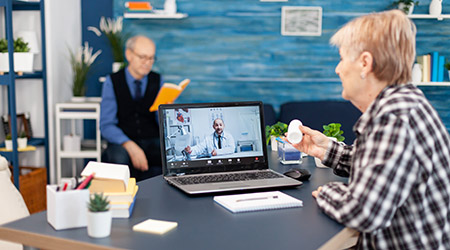The COVID-19 pandemic caused long-term care facilities to rapidly change their policies overnight. Telehealth was instantly adopted widely to reduce stress on the healthcare system by keeping residents safe and avoiding unnecessary transfers to already-overwhelmed hospitals.
A new study at the University of Missouri has found that the use of telehealth not only reduced stress for nursing home residents. It also increased access to convenient care. Kimberly Powell, an assistant professor in the MU Sinclair School of Nursing, interviewed nursing home clinicians and administrators from a sample of 700 nursing homes across the country to better understand the benefits and challenges of widespread telehealth adoption.
“Transporting a resident to the hospital can be a very traumatic and stressful experience,” says Kimberly Powell, assistant professor in the MU Sinclair School of Nursing. “Whether it’s a fall in the middle of the night or a sudden change in vitals, if a nurse can quickly hop on a Zoom call with a resident and make an assessment, perhaps an intervention plan can be developed that allows the resident to be treated in the nursing home, which saves time, money and an unnecessary transfer to the hospital.”
While telehealth offers numerous benefits, it can bring other impacts that managers should consider. Telehealth offers unprecedented convenience, it can also remove much needed socialization opportunities for older adults, but it can create confusion for nursing home residents with cognitive difficulties. Still, the implementation of telehealth went smoother for nursing homes that had previous experience using it.
“The pandemic highlighted the need for more technical training toward nursing homes that up until now had never used it before,” Powell says. “Going forward, there is also the need for better data integration so that when clinicians are on a Zoom call with nursing home residents, they can quickly and easily access medical records such as blood tests or lab results.”

 Building Sustainable Healthcare for an Aging Population
Building Sustainable Healthcare for an Aging Population Froedtert ThedaCare Announces Opening of ThedaCare Medical Center-Oshkosh
Froedtert ThedaCare Announces Opening of ThedaCare Medical Center-Oshkosh Touchmark Acquires The Hacienda at Georgetown Senior Living Facility
Touchmark Acquires The Hacienda at Georgetown Senior Living Facility Contaminants Under Foot: A Closer Look at Patient Room Floors
Contaminants Under Foot: A Closer Look at Patient Room Floors Power Outages Largely Driven by Extreme Weather Events
Power Outages Largely Driven by Extreme Weather Events